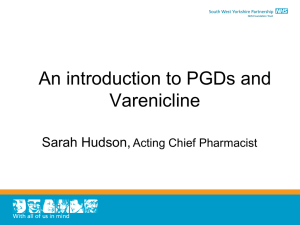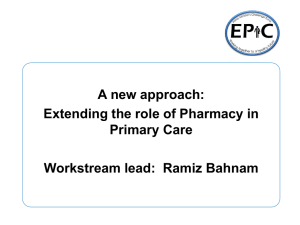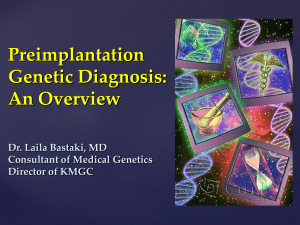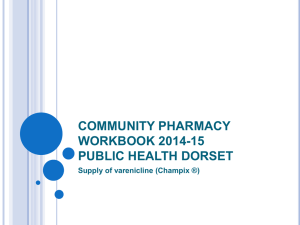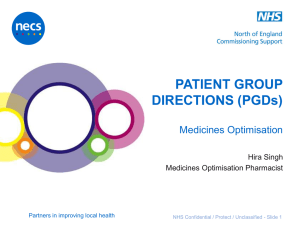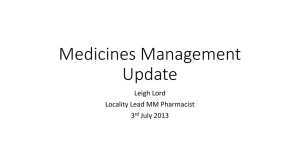PGD Presentation 2013 - Health Partnerships Learning
advertisement
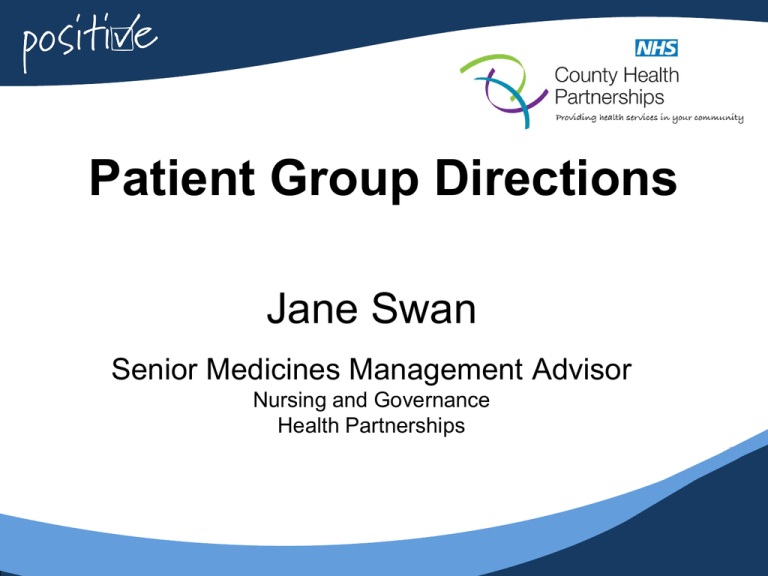
Patient Group Directions Jane Swan Senior Medicines Management Advisor Nursing and Governance Health Partnerships Aims & Learning Outcomes of the Session Learning outcomes Aims Develop an understanding of PGDs Discuss how to use PGDs safely Describe the background to Patient Group Directions (PGDs) Learn about some of the legal aspects of PGDs and how this impacts on your practice 2 The Crown Report 3 HSC 2000/026 4 What is a PGD? A specific written instruction for the supply and/or the administration of named medicines in an identified clinical situation. 5 Who do PGDS apply to? To groups of patients or other service users, who may not be individually identified before presentation for treatment. 6 Legislation 1968 Medicines Act and the Human Medicine Regulations 2012 regulate the use of medicines in the UK. There are 3 subsequent classifications of drugs once they have marketing authorisation. o GSL o P o POM 7 Drug Classifications GSL – (general sales list) Medicines sold in general shops as well as pharmacies P – (pharmacy medicine) Medicines sold in pharmacies by or under the supervision of a pharmacist POM – (prescription only medicine) Medicines only obtained on a prescription through a pharmacy 8 Restrictions on classes of drugs on PGD Controlled drugs ○ Some can be used – see later – but we do not encourage it Unlicensed medicines [unlicensed] ○ e.g. Mantoux test Off-label drugs [unlicensed] ○ If in line with current clinical practice e.g. NICE PGD must state product is outside licence and reasons for using. 9 Restrictions on classes of drugs on PGD Black Triangle drugs ○ Can be used in exceptional circumstances e.g. national guidelines. Yellow card reports for all side effects/adverse reactions Antibiotics ○ Can be used as long as measures to combat resistance are not compromised. A microbiologist should be involved in the construction of the PGD Appliances/dressings ○ Not licensed medicines 10 Who can work under a PGD? Pharmacists Registered dietitians Registered midwives Registered health visitors Registered nurses Registered occupational therapists Registered ophthalmic opticians Registered orthotists and prosthetists Registered speech and language therapists Registered chiropodists Registered orthoptists Registered physiotherapists Registered radiographers Registered paramedics 11 Which organisations can use PGDs? Special Health Authorities NHS Trusts A GP or dental practice, (providing NHS services) Non-NHS organisation providing treatment made under an arrangement with NHS trust/PCT Services funded by the NHS but provided by private, voluntary or charitable sector Independent hospitals, agencies or clinics registered under Care Standards Act 2000 Health care services provided by prison service Health care services provided by police service Health care services provided by armed forces 12 What information must a PGD contain? Clinical Drug Details Generic name, form and Indication strength of medicine Inclusion criteria Route or method of Exclusion criteria administration Cautions/ need for further Dosage advice Frequency Action if patient declines or Duration of treatment is excluded Maximum or minimum Advice to patient/carer treatment period Quantity to supply or Follow up/referral administer 13 What information must a PGD contain? Organisation The name of the organisation to which the direction applies (e.g. CHP, CityCare) The date the PGD comes into force and when it expires Signatures: o Pharmacist o Doctor o Organisation (Governance) Statement of the records to be kept for audit Staff Characteristics Each PGD will specify the professional group that is allowed to work under it Qualifications Specialist competencies and or qualifications Continuing training and education The professional who is to work with the PGD must sign the documentation before using the PGD You should tell your indemnity insurer you are using PGDs 14 Your responsibility Accountable ○ Required to answer for one’s conduct Responsible ○ Dependable, trustworthy, morally accountable Individuals using PGDs are accountable and responsible for their actions to: ○ The law ○ The patient/public ○ Their employer ○ Their professional body 15 To prescribe or to PGD? Prescribers see a patient after assessment and diagnosis, the need for a medicine is established as part of the treatment plan. A prescription is issued and dispensed. This is still the preferred route for patients to receive their medication and the only way to manage chronic disease. 16 To prescribe or to PGD? A PGD allows a range of healthcare professionals to supply and/or administer to a patient if they fit within an identified clinical criteria given in the PGD. The patient does not have to see a prescriber. 17 Process for Production and Implementation Identify a need for a PGD Complete proposal form and submit to the HCW PGD Group Once approved, the professional will devise and prepare PGD using the organisations template with assistance from a Pharmacist Submit draft PGD to HCW PGD Group for approval and Medicines Management Group informed Authorised for the organisation 18 Process for Production and Implementation Approved PGD signed, added to database, PDF’d and put on intranet. Author notified. Training and Competency assessment initiated for relevant staff Implement, monitor and audit. Review every two years or sooner if there are any evidence based changes to clinical practice which affect the PGD Medicines Management Group informed of any changes to PGD 19 Frequently Asked Questions Are PGDs appropriate for managing chronic disease? No. If a patient falls out of the inclusion criteria, can professional judgement be used to supply or administer a medicine? No. They must fall exactly into the criteria or be referred as per PGD guidelines. How long is PGD documentation kept for? Adults is eight years, Children until they are 25 or for eight years after their death. 20 Frequently Asked Questions Should patients receive patient information leaflets with any medicine supplied? Yes Can controlled drugs be supplied under the PGD framework? Some can: All drugs in schedule 4 except anabolic steroids. Recent changes authorise the supply of morphine and diamorphine by registered nurses and pharmacists under PGDs in any setting Can unlicensed medication be used under the PGD framework? No. Unlicensed medicines cannot be used. However an unlicensed indication of a licensed medicine can be used. Are prescription charges payable? Yes, unless usual exemption 21 22 23 PGD Document and Competency Framework Available at: http://www.npc.co.uk/ 24 Competency Framework THE CONSULTATION • Clinical and pharmaceutical knowledge • Establishing options • Communicating with patients EFFECTIVE SUPPLY AND ADMINISTRATION WITHIN A PGD •Safe PGD use •Professional standards •Practice development PGDs IN CONTEXT •Information in context •The NHS in context •The team and individual context 25 Intranet All HP & NottsHealthcare NHS Trust PGDs are posted on the intranet See Handout- http://inottshc/sitefiles/data/getmaindata.asp?cat=Patient Group Directions (PGDs)&id=4400&desc=PGDs that have been approved for use within Nottinghamshire Healthcare Trust&department=Pharmacy - Forensic Division If a service wants to start using them they must contact the Senior Medicines Management Advisor 26
